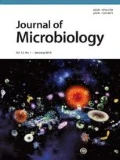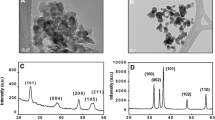Abstract
Zinc has antimicrobial activity and zinc salts including zinc chloride (ZnCl2) have been used for the control of oral malodor. In this study, we hypothesized that pyrrolidine dithiocarbamate (PDTC), a zinc ionophore, may enhance antimicrobial efficacy of ZnCl2. The bactericidal effectiveness of ZnCl2 alone (0.5–8 mM) or in combination with PDTC (1 or 10 μM) was evaluated by in vitro short (1 h) time-killing assays against Fusobacterium nucleatum and Porphyromonas gingivalis. Only a slight viability decrease was observed with ZnCl2 or PDTC alone after 1-h incubation. By contrast, combination of ZnCl2 and PDTC could achieve a more than 100-fold viability reduction compared with ZnCl2 or PDTC alone in F. nucleatum and P. gingivalis. Therefore, PDTC greatly enhanced the bactericidal activity of ZnCl2 against the oral malodor-producing bacteria. These results suggest that use of PDTC may be useful for enhancing bactericidal activity of antimalodor regimens of zinc salts.
Similar content being viewed by others
References
Camps, M. and J.C. Boothroyd. 2001. Toxoplasma gondii: selective killing of extracellular parasites by oxidation using pyrrolidine dithiocarbamate. Exp. Parasitol. 98, 206–214.
Citron, D.M. and D.W. Hecht. 2003. Susceptibility test methods: anaerobic bacteria, pp. 1141–1148. In P.R. Murray, E.J. Baron, J.H. Jorgensen, M.A. Pfaller, and R.H. Yolken (eds.). Manual of Clinical Microbiology, 8th ed. ASM Press Washington, D.C., USA.
Cuzzocrea, S., P.K. Chatterjee, E. Mazzon, L. Dugo, I. Serraino, D. Britti, G. Mazzullo, A.P. Caputi, and C. Thiemermann. 2002. Pyrrolidine dithiocarbamate attenuates the development of acute and chronic inflammation. Br. J. Pharmacol. 135, 496–510.
Delanghe, G., J. Ghyselen, C. Bollen, D. van Steenberghe, B.N. Vandekerckhove, and L. Feenstra. 1999. An inventory of patients’ response to treatment at a multidisciplinary breath odor clinic. Quintessence Int. 30, 307–310.
He, G., E.I. Pearce, and C.H. Sissons. 2002. Inhibitory effect of ZnCl2 on glycolysis in human oral microbes. Arch. Oral Biol. 47, 117–129.
Kang, M.S., E.K. Choi, D.H. Choi, S.Y. Ryu, H.H. Lee, H.C. Kang, J.T. Koh, et al. 2008. Antibacterial activity of pyrrolidine dithiocarbamate. FEMS Microbiol. Lett. 280, 250–254.
Lauzurica, P., S. Martinez-Martinez, M. Marazuela, P. Gómez del Arco, C. Martinez, F. Sánchez-Madrid, and J.M. Redondo. 1999. Pyrrolidine dithiocarbamate protects mice from lethal shock induced by LPS or TNF-α. Eur. J. Immunol. 29, 1890–1900.
Loesche, W.J. and C. Kazor. 2002. Microbiology and treatment of halitosis. Periodontol. 2000 28, 256–279.
Mochizuki, T., H. Satsu, and M. Shimizu. 2005. Signaling pathways involved in tumor necrosis factor α-induced upregulation of the taurine transporter in Caco-2 cells. FEBS Lett. 579, 3069–3074.
Munoz, C., D. Pascual-Salcedo, M.C. Castellanos, A. Alfranca, J. Aragones, A. Vara, J.M. Redondo, and M.O. de Landazuri. 1996. Pyrrolidine dithiocarbamate inhibits the production of interleukin-6, interleukin-8, and granulocyte-macrophage colony-stimulating factor by human endothelial cells in response to inflammatory mediators: modulation of NF-κB and AP-1 transcription factors activity. Blood 88, 3482–3490.
Nakano, Y., M. Yoshimura, and T. Koga. 2002. Correlation between oral malodor and periodontal bacteria. Microbes Infect. 4, 679–683.
Persson, S., R. Claesson, and J. Carlsson. 1989. The capacity of subgingival microbiotas to produce volatile sulfur compounds in human serum. Oral Microbiol. Immunol. 4, 169–172.
Persson, S., M.B. Edlund, R. Claesson, and J. Carlsson. 1990. The formation of hydrogen sulfide and methyl mercaptan by oral bacteria. Oral Microbiol. Immunol. 5, 195–201.
Roldan, S., E.G. Winkel, D. Herrera, M. Sanz, and A.J. van Winkelhoff. 2003. The effects of a new mouthrinse containing chlorhexidine, cetylpyridinium chloride and zinc lactate on the microflora of oral halitosis patients: a dual-centre, double-blind placebo-controlled study. J. Clin. Periodontol. 30, 427–434.
van den Broek, A.M.W.T., L. Feenstra, and C. de Baat. 2008. A review of the current literature on management of halitosis. Oral Dis. 14, 30–39.
Wäler, S.M. 1997. The effect of some metal ions on volatile sulfurcontaining compounds originating from the oral cavity. Acta Odontol. Scand. 55, 261–264.
Young, A., G. Jonski, G. Rölla, and S.M. Wäler. 2001. Effects of metal salts on the oral production of volatile sulfur-containing compounds (VSC). J. Clin. Periodontol. 28, 776–781.
Author information
Authors and Affiliations
Corresponding author
Rights and permissions
About this article
Cite this article
Choi, EK., Lee, HH., Kang, MS. et al. Potentiation of bacterial killing activity of zinc chloride by pyrrolidine dithiocarbamate. J Microbiol. 48, 40–43 (2010). https://doi.org/10.1007/s12275-009-0049-2
Received:
Accepted:
Published:
Issue Date:
DOI: https://doi.org/10.1007/s12275-009-0049-2




